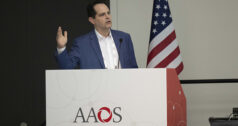
Surgeon inventors who are at various stages of the product development cycle crowded into a session room at this week’s AAOS Annual Meeting in search of guidance for turning their innovative ideas into commercialized devices.
“Create a credible threat to how surgery is performed,” said Derek Amanatullah, M.D., Ph.D., Associate Professor of Orthopedic Surgery at Stanford Medicine, who moderated the From Garage to Market: A Stepwise Approach to Creating an Orthopaedic Device symposium. “No one will invest in a device just because it’s better than the current options. Investors, decision-makers and competitors need to see undeniable proof of the threat to existing solutions before acting.”
The symposium’s discussions focused on the different stages of the startup journey, from early development to active fundraising and successful exits. A panel of experts shared their personal experiences about what worked, what didn’t and how they navigated challenges along the way. While the session room was filled with surgeons, the speakers’ advice was relevant for orthopedic engineers and product developers.
Dr. Amanatullah also shared the best piece of advice he received about developing and commercializing new devices: If you don’t give your idea away, you’ll never get anything back. Inventors shouldn’t relinquish the rights to their concept, but they should share it with a trusted team of advisors and partners to move it forward.
Developing the Team
Creating market impact requires more than just a great idea. Dr. Amanatullah said it demands entrepreneurship and skill sets that many surgeons don’t naturally possess. He advised surgeons to develop a team of experts who can help them navigate the critical steps of the commercialization journey, including protecting the intellectual property, creating corporate governance and gaining regulatory approval.
“We often believe that every small improvement — every retractor tweak or instrument modification — is profoundly important,” Dr. Amanatullah said. “And while some of these ideas may be highly valuable, the reality is that every great idea must be protectable, scalable and ultimately commoditized to make a real difference.”
One of the key goals of the AAOS symposium was to help surgeons move beyond the ideation phase. “That’s when everything changes,” Dr. Amanatullah said. “The concept may move beyond your expertise and require marketing, finance and entrepreneurial leadership to succeed.”
This step marks the true shift from invention to product development. The real challenge —and the defining factor of true innovation — occurs when an entrepreneur commits their time and energy to scaling a product, securing widespread adoption and ultimately achieving a successful exit.
Surgeons, by nature, believe they can put together tools to improve anatomy — something most people would consider an impossibly ambitious task. “But surgeons think differently,” Dr. Amanatullah said. “We understand anatomy, physiology and medical devices, and we see how they can be combined into cohesive systems. That mindset naturally lends itself to innovation.”
Many surgeons start down the innovation path believing they must manage every step of the innovation lifecycle themselves, but that’s not the best way to approach the process.
“Surgeons need to open their network and find the right team members,” Dr. Amanatullah said. “Idea people need patent experts, product development specialists and entrepreneurs who can help turn their vision into a scalable business. The key question is: Who’s the next person to bring on board to push your idea forward? Having the right collaborators is what turns an idea into something real.”
Finding Value
For a product to succeed on the market, its value proposition must align with its cost, price and the clinical impact that it delivers. It also needs to create synergies for providers and fit within the broader healthcare system.
“A product with a high commercial value might not need to meet as high of a clinical burden to gain adoption,” Dr. Amanatullah said. “But if its clinical impact is significant, there may be greater pricing flexibility. These factors are interdependent and must be carefully balanced.”
This is why entrepreneurship is distinct from product development.
“A great product alone isn’t enough — it must compete across multiple dimensions, including clinical outcomes, efficiency, cost of goods, pricing strategy and reimbursement models,” Dr. Amanatullah said. “Ultimately, every entrepreneur will approach this positioning differently.
“The way an innovation is framed in the market — its business model, pricing and strategic positioning — is just as critical as the product itself. Success isn’t about having a great idea or invention. It’s about navigating the complex ecosystem that determines whether it will make an impact.”
Surgeons recognize the potential for a platform that could drive future clinical advancements, according to Dr. Amanatullah, who said the challenge lies in demonstrating its potential while also ensuring there’s a sustainable financial model supporting it.
“If patients seek out the technology and generate volume, it becomes a viable part of the healthcare ecosystem, even if today’s studies don’t yet show significant clinical benefits,” he said.
Plus, outcomes are measured differently across stakeholders. Hospitals focus on volume-based metrics and charge-based outcomes. Insurers assess CPT codes and relative value units (RVUs). Clinicians evaluate direct patient benefits and procedural improvements. Successful innovation must navigate at least one of these value chains to move forward.
For providers to adopt new technology, they must see a future in which it delivers clinical value — not just increased utilization or financial returns.
“That value doesn’t have to exist today,” Dr. Amanatullah. “Many emerging technologies show minimal immediate impact, but their true value is realized in later iterations. The key is sustaining an ecosystem where innovation can evolve.”
Daniel Martin, M.D., President and CEO of Syntorr, has spent his entire career working on the development of orthopedic hardware and founded two companies. He advised the surgeons to vet their ideas by gathering feedback from clinical colleagues. Would it improve the way they perform surgery? Just as importantly, would they use the device?
“A proposed device won’t make it to market if surgeons won’t use it, even if it solves a clinical problem,” Dr. Martin said. “Coming up with a good idea is not enough.”
Beating the Odds
The only certainty of the commercialization pathway is that it’s long and winding.
“There is no straight path,” Dr. Amanatullah said. “You need to find your own way — and be prepared to work tirelessly to achieve your goals.”
He also acknowledged the difficulty in successfully bringing an idea to market.
“Most of our time is spent in the ideation phase,” Dr. Amanatullah said. “This is the cheapest phase, where we generate hundreds of ideas, knowing that only a fraction will become true inventions. From those inventions, only a handful will evolve into viable innovations — business-worthy concepts with real market demand. And of those, only one in hundreds will achieve a successful exit and make a lasting impact on the field.”
Innovation isn’t about sudden, groundbreaking discoveries. Instead, it’s a process of iterative experimentation, working safely within known limits to ensure that innovation leads to positive outcomes and serves the best interests of patients.
Surgeon entrepreneurs must believe in what they’re building and have realistic expectations about what’s involved in moving their designs from the garage to the market. It takes years of tireless and, at times, frustrating work. Dr. Amanatullah said surgeon must embrace all aspects of the process and come at it with the right intentions.
“You need to be internally driven. If the motivation is purely external — solely about making money — your work won’t be worth the effort,” he said. “There are far easier ways to earn a living. True innovation requires something deeper: a personal commitment to making an impact on the lives of patients.”
DC
Dan Cook is a Senior Editor at ORTHOWORLD. He develops content focused on important industry trends, top thought leaders and innovative technologies.




